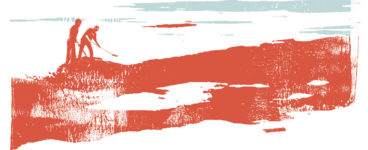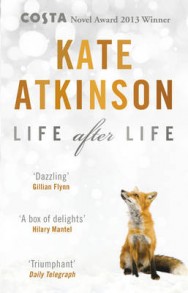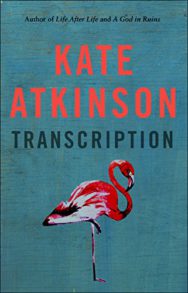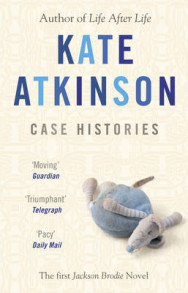‘There was a trollish look to him, as if he had been put together from leftovers. He could have been sent over from Booking [a department at the BBC, where Juliet works] to play one of the dispossessed. A hunched shoulder, eyes like pebbles … and pockmarked skin that looked as if it had been peppered by shot. (Perhaps it had been). The wounds of war, Juliet thought, rather pleased with the way the words sounded in her head. It could be the title for a novel. Perhaps she should write one.’
David Robinson finds echoes of Muriel Spark and William Boyd in Kate Atkinson’s latest novel, a book that only confirms her reputation as one of the UK’s most talented novelists.
David Robinson Reviews: Transcription
By Kate Atkinson
Published by Doubleday
London,1950. Juliet Armstrong, a BBC radio producer on her lunch-break, is drinking a cup of coffee in Moretti’s cafe, wondering why a former colleague has just blanked her in the street. Ten years ago, when they were both working for MI5 – him as an agent with a string of closet British Nazi-supporting informants convinced he was a German spy, her as a secretary transcribing their bugged conversations – they had worked closely together. Now, it appears, she is being targeted by someone they brought to justice, and he doesn’t want to know. Why?
That’s a much smaller question than those huge existential ones at the core of Kate Atkinson’s last two Costa-wining novels, Life After Life and A God in Ruins, but it’s central to Transcription. Its plot spins out from historical facts – there were such MI5 stings of British Nazi supporters, those transcribed conversations were archived, similar arrests were made – into something more dizzyingly head-spinning. But at its core, this is Atkinson taking on the conventions of the spy novel and making them her own. She’s already successfully done that to crime fiction with her Jackson Brodie novels (Case Histories, noted Stephen King, was “the best mystery of the decade”). I suppose she’ll be tackling science fiction next.
To look closer at Atkinson’s craft, it might be instructive to make a brief comparison with William Boyd’s Restless, with which Transcription has a lot in common: a Second World War setting, a female narrator who becomes a spy, MI5 manoeuvrings to keep the US as a potential ally (though these are more extensive in Boyd’s novel) and massive post-war plot complications. When Restless won the Costa Best Novel Prize in 2006 the judges noted that it “remained a page-turner despite the complexity of the wartime intrigue” and “reeked with riveting detail and authenticity”. This is true of Atkinson’s novel too, yet for all these similarities, the differences are enormous. Let’s look at them in greater detail.
Rather than follow the plot, let’s look in detail at that scene near the start of the book in Moretti’s cafe. In it, we can see how cleverly Atkinson sets about subverting the spy novel.
She is, like Muriel Spark, the queen of the flashback and the flash-forward, and this particular scene is a mixture of both: it reaches back far into the past, but foreshadows a key part of the plot. Why does Juliet go to Moretti’s that particular day in 1950? Not just because it’s nearby, but because to her it’s been a constant in a changing world. In the late 1930s, when her mother was dying in the Middlesex Hospital, the 17-year-old Juliet was a regular. The proprietor would always ask after her mother, not that he’d ever met her but because that was the Italians for you (“keener on their mothers than the British were”) and when he did, Juliet would answer “Very well thank you, Mr Moretti”.
There’s a strange-looking character in the cafe that day in 1950 who will figure later in the plot: technically, introducing him is the main point of the scene. Yet Atkinson tells you so much more. First of all, we see that even as a girl, Juliet was happy to invent her own reality (her mother was actually dying, not “very well, thank you”). Yet as she thinks back to Moretti and the cheese and toast and Viennese coffees he used to make, she fingers her pearls and remembers how he drowned on the SS Andora Star in 1940 alongside hundreds of other Italian PoWs. That, in turn, puts her in mind of other people she knew who died in the war, like the original owner of her pearl necklace, whose body she had helped to shift … “But best not to think about that. Thinking had always been her downfall.”
This is still, remember, very early on, and all in the same short scene. There’s not been a clue about whose body Juliet has taken the pearls from, not a hint as to why thinking has always been Juliet’s downfall. But the hooks are in, and they will get you reading the rest of the novel, and somehow they go in deeper because they are not as part of a simply revealed plot but one which has already hopped back 12 years, provided a snippet of Juliet’s character (lying about her mother) and a small slice of humour (“Italians keener on their mothers”). The scene also shows Atkinson’s assurance with metaphors, Juliet’s fingered pearls making her realise that “everything was connected, a great web that stretched across time and history”: this same web also includes Moretti and the as yet unknown original owner of the pearl necklace.
Every time Atkinson makes a plot point, in other words, she is making about three others at the same time – different kinds, but each adding to the overall richness of her narrative. Although she writes in the third person, she turns it into an endlessly questioning interior monologue. Here, for example, is what Juliet makes of that odd-looking man in the cafe:
“There was a trollish look to him, as if he had been put together from leftovers. He could have been sent over from Booking [a department at the BBC, where Juliet works] to play one of the dispossessed. A hunched shoulder, eyes like pebbles … and pockmarked skin that looked as if it had been peppered by shot. (Perhaps it had been). The wounds of war, Juliet thought, rather pleased with the way the words sounded in her head. It could be the title for a novel. Perhaps she should write one.”
Later on, we will learn more about how clearly words sound in Juliet’s head – especially the words of the Nazi sympathisers she has had to transcribe and which she then, as a spy, finds herself using. That’s when Atkinson’s novel is at both its cleverest and most dramatic – and one could indeed imagine a novelist of Boyd’s calibre handling such scenes equally well.
What even Boyd can’t match Atkinson for, though, are those earlier scenes when nothing is happening plot-wise but we are listening to the random questions babbling in Juliet’s mind. What kind of dogs do her colleagues in the BBC’s Schools Department most resemble? Or: “What was so wonderful about an ugly old man who kept painting himself all the time?” (Rembrandt, though she knows never to say so). Even moments of tension can – here we go genre-subverting again –are often deflated with one of Juliet’s dafter thoughts.
Yet, before all of this becomes too whimsical, Atkinson will snatch you back to 1940 when the pro-Nazi aristocrats of the Right Club are reading in the newspapers about the Germans crossing the Meuse, and thinking that out is only a matter of time – days, not weeks – before Britain will fall. She will tell a suspenseful spy story that is a model of its type, she will fuse it with a genuinely deep level of knowledge about the wartime MI5 and the post-war BBC, and she will make you laugh out loud too. Not for the first time, I’m in awe at her talent.
Transcription by Kate Atkinson is published by Doubleday on 6 September, priced £20.
ALSO IN THIS ISSUE

 Into the Peatlands: A Journey Through the Moorland Year
Into the Peatlands: A Journey Through the Moorland Year
‘She was taken out onto the moor where the family had for generations cut the thick, muddy peat to b …

 As the Women Lay Dreaming
As the Women Lay Dreaming
‘Time reels back and forth, shifting like a shuttle in one of those Hattersley looms that used to be …















